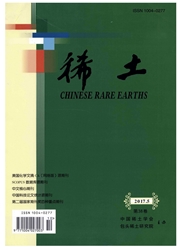

 中文摘要:
中文摘要:
本文采用溶剂热法制备了不同Cl-Br摩尔比的BiOClxBr1-x,并借助X射线衍射仪(XRD)、扫描电子显微镜(SEM)及透射电子显微镜(TEM)对其进行了检测与表征 结果表明,该试验方法能够得到较好晶体结构的BiOClxBr1-x光催化剂 通过使用不同Cl-Br摩尔比的BiOClxBr1-x对甲基橙(MO)溶液进行降解后发现,BiOCl0.4Br0.6光催化剂的降解性能最好,在180 min时其降解率可达39 7%,优于单卤纯BiOCl(180 min时降解率为13 6%)和纯BiOBr(180 min时降解率为21 8%)的降解性能 然后,又使用紫外可见光谱仪(UV-vis)、光致发光光谱仪(PL)对BiOClxBr1-x光催化性能进行了检测分析;为进一步弄清BiOClxBr1-x的光催化机理,又对加入抑制剂BiOCl0.4Br0.6光催化剂进行了对比试验,结果表明h+在光降解过程中起主要的催化作用 .
 英文摘要:
英文摘要:
BiOClxBr1-x with different Cl-Br mole ratios made by solvothermal method was studied, and was characteristed by X-ray diffraction (XRD), scanning electron microscopy (SEM) and transmission electron microscope (TEM). The results show that by using this method, BiOClxBr1-x photocatalyst with better crystal structure can be obtained. After the degradation of methyl orange (MO) solution for BiOClxBr1-x with different Cl-Br molar ratios, it was found that material BiOCl0.4Br0.6 had the best degradation performance, and the degradation rate was up to 39 7% at 180 min,and the degradation performance of the pure BiOCl (degradation rate of 13 6% at 180 min) was better than the pure BiOBr (21 8% degradation at 180 min). Then, the photocatalytic activity of BiOClxBr1-x was detected by UV-vis and photoluminescence spectroscopy (PL). In order to further understand the photocatalytic mechanism of BiOClxBr1-x, inhibitors were adopted in BiOCl0.4Br0.6 photocatalyst, and the results show that the h+ plays a major role in the photodegradation process.
 同期刊论文项目
同期刊论文项目
 同项目期刊论文
同项目期刊论文
 期刊信息
期刊信息
